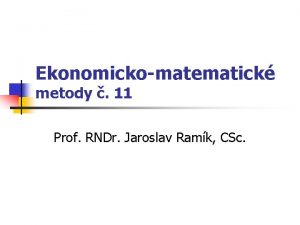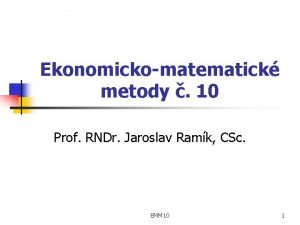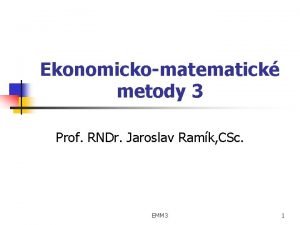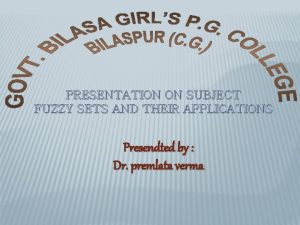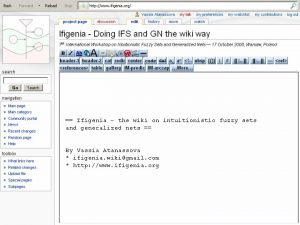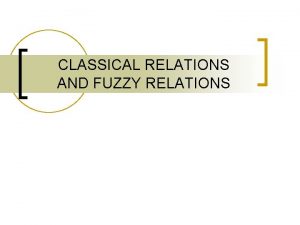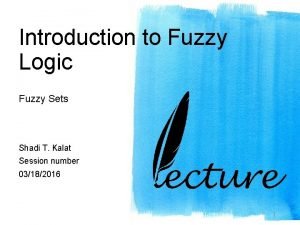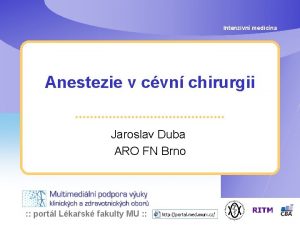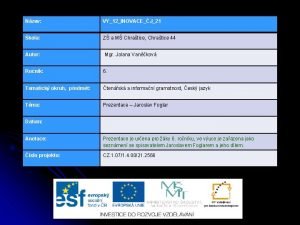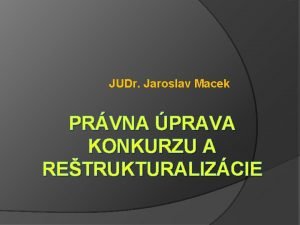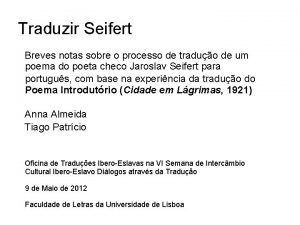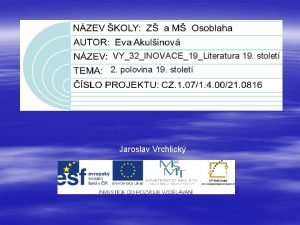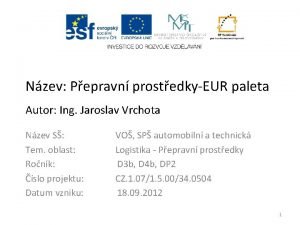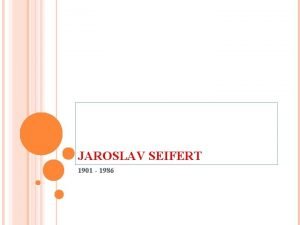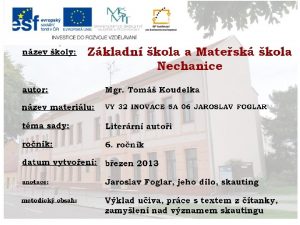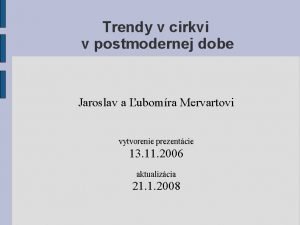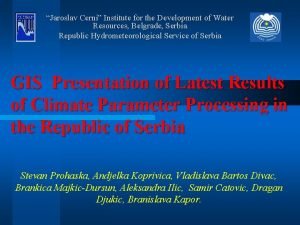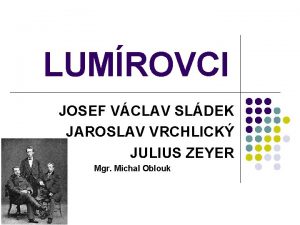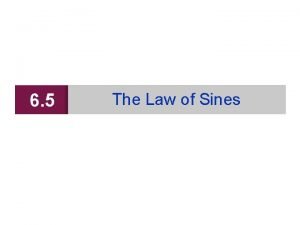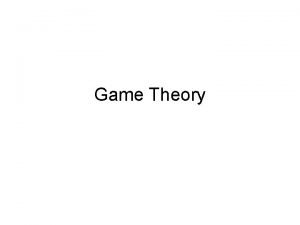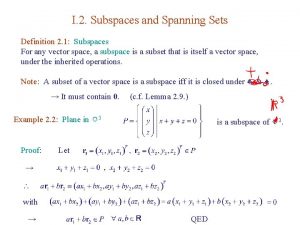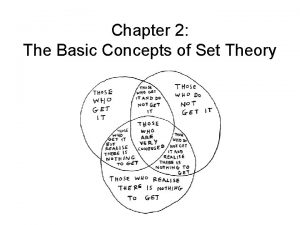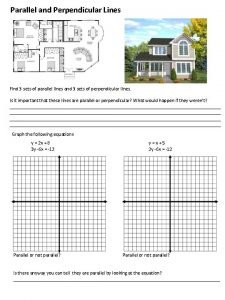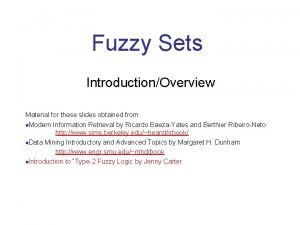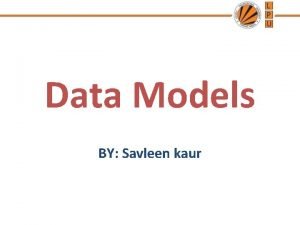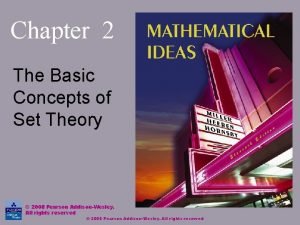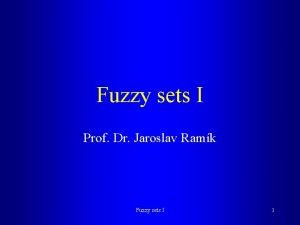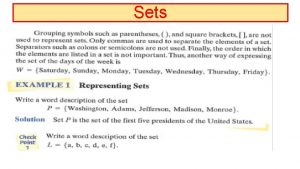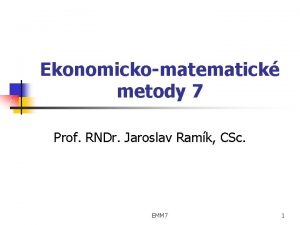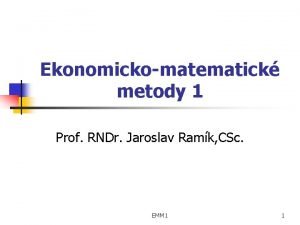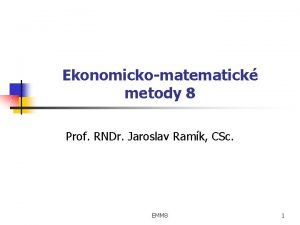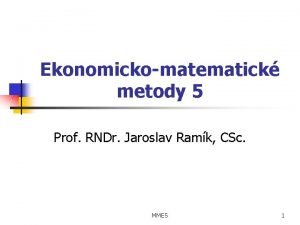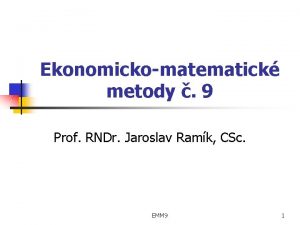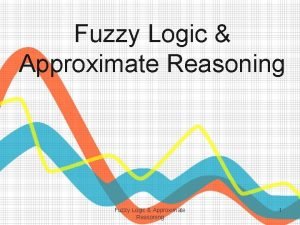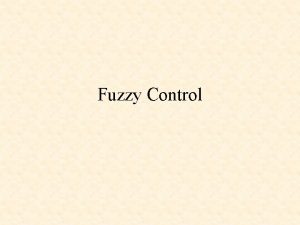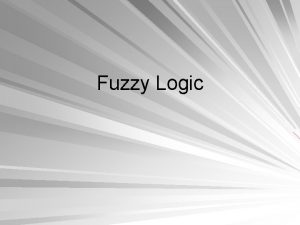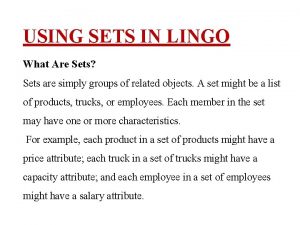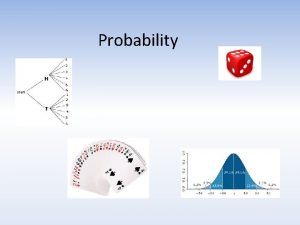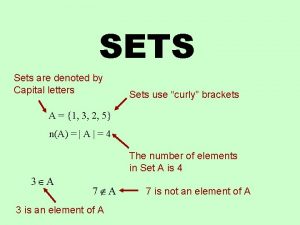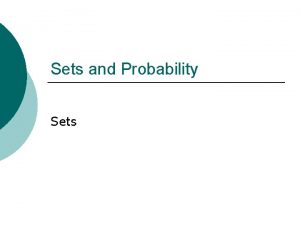Fuzzy sets II Prof Dr Jaroslav Ramk Fuzzy





















![Probability measure F - -Algebra of events of p : F [0, 1] - Probability measure F - -Algebra of events of p : F [0, 1] -](https://slidetodoc.com/presentation_image/4ca35fbcfa7dbd340f3287c1d6b90201/image-22.jpg)
![Fuzzy measure F - -Algebra of events of g : F [0, 1] - Fuzzy measure F - -Algebra of events of g : F [0, 1] -](https://slidetodoc.com/presentation_image/4ca35fbcfa7dbd340f3287c1d6b90201/image-23.jpg)




![Possibility distribution • - possibility measure on P( ) • Function : [0, 1] Possibility distribution • - possibility measure on P( ) • Function : [0, 1]](https://slidetodoc.com/presentation_image/4ca35fbcfa7dbd340f3287c1d6b90201/image-28.jpg)




![Possibility of fuzzy event - set of elementary outcomes : [0, 1] - possibility Possibility of fuzzy event - set of elementary outcomes : [0, 1] - possibility](https://slidetodoc.com/presentation_image/4ca35fbcfa7dbd340f3287c1d6b90201/image-33.jpg)







![References [1] J. Ramík, M. Vlach: Generalized concavity in fuzzy optimization and decision analysis. References [1] J. Ramík, M. Vlach: Generalized concavity in fuzzy optimization and decision analysis.](https://slidetodoc.com/presentation_image/4ca35fbcfa7dbd340f3287c1d6b90201/image-41.jpg)
- Slides: 41

Fuzzy sets II Prof. Dr. Jaroslav Ramík Fuzzy sets II 1

Content • • Extension principle Extended binary operations with fuzzy numbers Extended operations with L-R fuzzy numbers Extended operations with t-norms Probability, possibility and fuzzy measure Probability and possibility of fuzzy event Fuzzy sets of the 2 nd type Fuzzy relations Fuzzy sets II 2

Extension principle (EP) by L. Zadeh, 1965 • EP makes possible to extend algebraical operations with NUMBERS to FUZZY SETS • Even more: EP makes possible to extend REAL FUNCTIONS of real variables to FUZZY FUNCTIONS with fuzzy variables • Even more: EP makes possible to extend CRISP CONCEPTS to FUZZY CONCEPTS (e. g. relations, convergence, derivative, integral, etc. ) Fuzzy sets II 3

Example 1. Addition of fuzzy numbers EP: Fuzzy sets II 4

Theorem 1. Let • the operation denotes + or · (add or multiply) • - fuzzy numbers, [0, 1] • - -cuts Then is defined by its -cuts as follows [0, 1] Fuzzy sets II 5

Extension principle for functions • X 1, X 2, …, Xn, Y - sets • n - fuzzy sets on Xi , i = 1, 2, …, n • g : X 1 X 2 … Xn Y - function of n variables i. e. (x 1, x 2 , …, xn ) y = g (x 1, x 2 , …, xn ) Then the extended function is defined by Fuzzy sets II 6

Remarks • g-1(y) = {(x 1, x 2 , …, xn ) | y = g (x 1, x 2 , …, xn )} - co-image of y • Special form of EP: g (x 1, x 2) = x 1+x 2 or g (x 1, x 2) = x 1*x 2 • Instead of Min any t-norm T can be used - more general for of EP Fuzzy sets II 7

Example 2. Fuzzy Min and Max Fuzzy sets II 8

Extended operations with L-R fuzzy numbers • L, R : [0, + ) [0, 1] - decreasing functions shape Left spread Right spread • L(0) = R(0) = 1, m - main value, > 0 • = (m, , )LR - fuzzy number of L-R-type if • Fuzzy sets II 9

Example 3. L-R fuzzy number “About eight” Fuzzy sets II 10

Example 4. L(u) = Max(0, 1 ‑ u) R(u) = Fuzzy sets II 11

Addition Theorem 2. Let = (m, , )LR , = (n, , )LR where L, R are shape functions Then is defined as Example: (2, 3, 4)LR (1, 2, 3)LR = (3, 5, 7)LR Fuzzy sets II 12

Opposite FN = (m, , )LR - FN of L-R-type = (m, , )LR - opposite FN of L-R-type to “Fuzzy minus” Fuzzy sets II 13

Subtraction Theorem 3. Let = (m, , )LR , = (n, , )LR where L, R are shape functions Then is defined as Example: (2, 3, 4)LR (1, 2, 3)LR = (1, 6, 6)LR Fuzzy sets II 14

Example 5. Subtraction Fuzzy sets II 15

Multiplication Theorem 4. Let = (m, , )LR , = (n, , )LR where L, R are shape functions Then is defined by approximate formulae: 1. 2. Example by 1. : (2, 3, 4)LR (1, 2, 3)LR (2, 7, 10)LR Fuzzy sets II 16

Example 6. Multiplication = (2, 1, 2)LR , = (4, 2, 2)LR (8, 8, 12)LR formula 1. - - formula 2. ……. exact function Fuzzy sets II 17

Inverse FN = (m, , )LR > 0 - FN of L-R-type - approximate formula 1 - approximate formula 2 We define inverse FN only for positive (or negative) FN ! Fuzzy sets II 18

Example 7. Inverse FN = (2, 1, 2)LR f. 1: formula 1. f. 2: - - formula 2. ……. exact function Fuzzy sets II 19

Division = (m, , )LR , = (n, , )LR > 0 where L, R are shape functions Define Combinations of approximate formulae, e. g. Fuzzy sets II 20

Probability, possibility and fuzzy measure Sigma Algebra ( -Algebra) on : F - collection of classical subsets of the set satisfying: (A 1) F (A 2) if A F then CA F (A 3) if Ai F, i = 1, 2, . . . then i Ai F - elementary space (space of outcomes - elementary events) F - -Algebra of events of Fuzzy sets II 21
![Probability measure F Algebra of events of p F 0 1 Probability measure F - -Algebra of events of p : F [0, 1] -](https://slidetodoc.com/presentation_image/4ca35fbcfa7dbd340f3287c1d6b90201/image-22.jpg)
Probability measure F - -Algebra of events of p : F [0, 1] - probability measure on F satisfying: (W 1) if A F then p(A) 0 (W 2) p( ) = 1 (W 3) if Ai F , i = 1, 2, . . . , Ai Aj = , i j then p( i Ai ) = i p(Ai ) - -additivity (W 3*) if A, B F , A B= , then p(A B ) = p(A ) + p(B) - additivity Fuzzy sets II 22
![Fuzzy measure F Algebra of events of g F 0 1 Fuzzy measure F - -Algebra of events of g : F [0, 1] -](https://slidetodoc.com/presentation_image/4ca35fbcfa7dbd340f3287c1d6b90201/image-23.jpg)
Fuzzy measure F - -Algebra of events of g : F [0, 1] - fuzzy measure on F satisfying: (FM 1) p( ) = 0 (FM 2) p( ) = 1 (FM 3) if A, B F , A B then p(A) p(B) - monotonicity (FM 4) if A 1, A 2, . . . F , A 1 A 2 . . . then g(Ai ) = g( Ai ) - continuity Fuzzy sets II 23

Properties • Additivity condition (W 3) is stronger than monotonicity (MP 3) & continuity (MP 4) i. e. • (W 3) (MP 3) & (MP 4) • Consequence: Any probability measure is a fuzzy measure but not contrary Fuzzy sets II 24

Possibility measure P( ) - Power set of (st of all subsets of ) : P( ) [0, 1] - possibility measure on satisfying: (P 1) ( ) = 0 (P 2) ( ) = 1 (P 3) if Ai P( ) , i = 1, 2, . . . then ( i Ai ) = Supi {p(Ai )} (P 3*) if A, B P( ) , then (A B ) = Max{ (A ), (B)} Fuzzy sets II 25

Properties • Condition (P 3) is stronger than monotonicity (MP 3) & continuity (MP 4) i. e. • (P 3) (MP 3) & (MP 4) • Consequence: Any possibility measure is a fuzzy measure but not contrary Fuzzy sets II 26

Example 8. = A B C F = { , A, B, C, A B, B C, A B C} Fuzzy sets II 27
![Possibility distribution possibility measure on P Function 0 1 Possibility distribution • - possibility measure on P( ) • Function : [0, 1]](https://slidetodoc.com/presentation_image/4ca35fbcfa7dbd340f3287c1d6b90201/image-28.jpg)
Possibility distribution • - possibility measure on P( ) • Function : [0, 1] defined by (x) = ({x}) for x is called a possibility distribution on Interpretation: is a membership function of a fuzzy set , i. e. (x) = A(x) x , A(x) is the possibility that x belongs to Fuzzy sets II 28

Probability and possibility of fuzzy event Example 1: What is the possibility (probability) that tomorrow will be a nice weather ? Example 2: What is the possibility (probability) that the profit of the firm A in 2003 will be high ? • nice weather, high profit - fuzzy events Fuzzy sets II 29

Probability of fuzzy event Finite universe ={x 1, …, xn} - finite set of elementary outcomes F - -Algebra on P - probability measure on F - fuzzy set of , with the membership function A(x) - fuzzy event, A F for [0, 1] P( ) = - probability of fuzzy event Fuzzy sets II 30

Probability of fuzzy event Real universe = R - real numbers - set of elementary outcomes F - -Algebra on R P - probability measure on F given by density fction g - fuzzy set of R, with the membership function A(x) - fuzzy event A F for [0, 1] P( ) = - probability of fuzzy event Fuzzy sets II 31

Example 9. = (4, 1, 2)LR L(u) = R(u) = e-u - “around 4” - density function of random value = 0, 036 Fuzzy sets II 32
![Possibility of fuzzy event set of elementary outcomes 0 1 possibility Possibility of fuzzy event - set of elementary outcomes : [0, 1] - possibility](https://slidetodoc.com/presentation_image/4ca35fbcfa7dbd340f3287c1d6b90201/image-33.jpg)
Possibility of fuzzy event - set of elementary outcomes : [0, 1] - possibility distribution - fuzzy set of , with the membership function A(x) - fuzzy event A F for [0, 1] P( ) = - possibility of fuzzy event Fuzzy sets II 33

Fuzzy sets of the nd 2 type • The function value of the membership function is again a fuzzy set (FN) of [0, 1] Fuzzy sets II 34

Example 10. Fuzzy sets II 35

Example 11. Linguistic variable “Stature”- Height of the body Fuzzy sets II 36

Fuzzy relations • X - universe • - (binary) fuzzy (valued) relation on X = fuzzy set on X X is given by the membership function R : X X [0, 1] FR is: • Reflexive: R (x, x) = 1 x X • Symmetric: R (x, y) = R (y, x) x, y X • Transitive: Supz[Min{ R (x, z), R (z, y)}] R (x, y) • Equivalence: reflexive & symmetric & transitive Fuzzy sets II 37

Example 12. Binary fuzzy relation : “x is much greater than y” e. g. R(8, 1) = 7/9 = 0, 77… - is antisymmetric: If R (x, y) > 0 then R (y, x) = 0 x, y X Fuzzy sets II 38

Example 13. Binary fuzzy relation : “x is similar to y” X = {1, 2, 3, 4, 5} x/y 1 2 3 4 5 1 1, 0 0, 5 0, 3 0, 2 0, 5 1, 0 0, 6 0, 5 0, 2 3 0, 6 1, 0 0, 7 0, 4 4 0, 2 0, 5 0, 7 1, 0 0, 4 5 0 0, 2 0, 4 0, 8 1, 0 is equivalence ! Fuzzy sets II 39

Summary • • Extension principle Extended binary operations with fuzzy numbers Extended operations with L-R fuzzy numbers Extended operations with t-norms Probability, possibility and fuzzy measure Probability and possibility of fuzzy event Fuzzy sets of the 2 nd type Fuzzy relations Fuzzy sets II 40
![References 1 J Ramík M Vlach Generalized concavity in fuzzy optimization and decision analysis References [1] J. Ramík, M. Vlach: Generalized concavity in fuzzy optimization and decision analysis.](https://slidetodoc.com/presentation_image/4ca35fbcfa7dbd340f3287c1d6b90201/image-41.jpg)
References [1] J. Ramík, M. Vlach: Generalized concavity in fuzzy optimization and decision analysis. Kluwer Academic Publ. Boston, Dordrecht, London, 2001. [2] H. -J. Zimmermann: Fuzzy set theory and its applications. Kluwer Academic Publ. Boston, Dordrecht, London, 1996. [3] H. Rommelfanger: Fuzzy Decision Support - Systeme. Springer - Verlag, Berlin Heidelberg, New York, 1994. [4] H. Rommelfanger, S. Eickemeier: Entscheidungstheorie - Klassische Konzepte und Fuzzy Erweiterungen, Springer - Verlag, Berlin Heidelberg, New York, 2002. Fuzzy sets II 41
 Image sets
Image sets Ramk
Ramk Ramk
Ramk Lmmel
Lmmel Ramk
Ramk Decomposition theorem of fuzzy sets
Decomposition theorem of fuzzy sets Fuzzy logic wiki
Fuzzy logic wiki Intersection of fuzzy sets
Intersection of fuzzy sets Cartesian product of fuzzy sets
Cartesian product of fuzzy sets Bounded sum in fuzzy logic
Bounded sum in fuzzy logic Dubaaro
Dubaaro Jaroslav foglar prezentace
Jaroslav foglar prezentace Jaroslav hašek prezentace
Jaroslav hašek prezentace Znaky poetismu
Znaky poetismu Judr jaroslav macek
Judr jaroslav macek Jaroslav seifert poemas
Jaroslav seifert poemas Jaroslav seifert kytička fialek
Jaroslav seifert kytička fialek Za trochu lásky šel bych světa kraj rozbor
Za trochu lásky šel bych světa kraj rozbor Jaroslav zavadil
Jaroslav zavadil Jaroslav vrchota
Jaroslav vrchota Jaroslav seifert prezentace
Jaroslav seifert prezentace Rozpočítadlo petrklíč
Rozpočítadlo petrklíč Jaroslav foglar wikipedie
Jaroslav foglar wikipedie Jaroslav najbert
Jaroslav najbert Jaroslav duba
Jaroslav duba Jaroslav kříž pastor
Jaroslav kříž pastor Jcerni
Jcerni Jaroslav seifert kytička fialek
Jaroslav seifert kytička fialek Judr jaroslav macek
Judr jaroslav macek Zeyer
Zeyer Odrody kremena
Odrody kremena Spark: cluster computing with working sets
Spark: cluster computing with working sets A pilot sets out from an airport and heads in the direction
A pilot sets out from an airport and heads in the direction Base station test sets
Base station test sets Information sets in game theory
Information sets in game theory Minimum spanning set
Minimum spanning set Basic concepts of sets
Basic concepts of sets Sets sagkeeng
Sets sagkeeng Lesson 12-4 slopes of parallel and perpendicular lines
Lesson 12-4 slopes of parallel and perpendicular lines Sets
Sets Removing redundant attributes in entity sets
Removing redundant attributes in entity sets Concepts of set
Concepts of set

